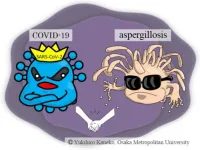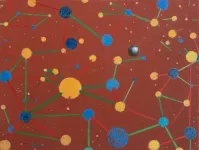(Press-News.org) Iron is a micronutrient indispensable for life, enabling processes such as respiration, photosynthesis, and DNA synthesis. Iron availability is often a limiting resource in today’s oceans, which means that increasing the flow of iron into them can increase the amount of carbon fixed by phytoplankton, with consequences for the global climate.
Iron ends up in oceans and terrestrial ecosystems through rivers, melting glaciers, hydrothermal activity, and especially wind. But not all its chemical forms are ‘bioreactive’, that is, available for organisms to take up from their environment.
“Here we show that iron bound to dust from the Sahara blown westward over the Atlantic has properties that change with the distance traveled: the greater this distance, the more bioreactive the iron,” said Dr Jeremy Owens, an associate professor at Florida State University and a co-author on a new study in Frontiers in Marine Science.
“This relationship suggests that chemical processes in the atmosphere convert less bioreactive iron to more accessible forms.”
The core of the matter
Owens and colleagues measured the amounts of bioreactive and total iron in drill cores from the bottom of the Atlantic Ocean, collected by the International Ocean Discovery Program (IODP) and its earlier versions. IODP aims to improve our understanding of changing climate and oceanic conditions, geological processes, and the origin of life. The researchers selected four cores, based on their distance from the so-called Sahara-Sahel Dust Corridor. The latter ranges from Mauritania to Chad and is known to be an important source of dust-bound iron for downwind areas.
The two cores closest to this corridor were collected approximately 200km and 500km west of northwestern Mauritania, a third in the mid-Atlantic, and the fourth approximately 500km to the east of Florida. The authors studied the upper 60 to 200 meters of these cores, reflecting deposits over to the last 120,000 years – the time since the previous interglacial.
They measured the total iron concentrations along these cores, as well as concentrations of iron isotopes with a plasma-mass spectrometer. These isotope data were consistent with dust from the Sahara.
They then used a suite of chemical reactions to reveal the fractions of total iron present in the sediments in the form of iron carbonate, goethite, hematite, magnetite, and pyrite. The iron in these minerals, while not bioreactive, likely formed from more bioreactive forms through geochemical processes on the seafloor.
“Rather than focusing on the total iron content as previous studies had done, we measured iron that can dissolve easily in the ocean, and which can be accessed by marine organisms for their metabolic pathways,” said Owens.
“Only a fraction of total iron in sediment is bioavailable, but that fraction could change during transport of the iron away from its original source. We aimed to explore those relationships.”
Blowing in the wind
The results showed that the proportion of bioreactive iron was lower in the westernmost cores than in the easternmost ones. This implied that a correspondingly greater proportion of bioreactive iron had been lost from the dust and presumably been used by organisms in the water column, so that it had never reached the sediments at the bottom.
“Our results suggest that during long-distance atmospheric transport, the mineral properties of originally non-bioreactive dust-bound iron change, making it more bioreactive. This iron then gets taken up by phytoplankton, before it can reach the bottom,” said Dr Timothy Lyons, a professor at the University of California at Riverside and the study’s final author.
“We conclude that dust that reaches regions like the Amazonian basin and the Bahamas may contain iron that is particularly soluble and available to life, thanks to the great distance from North Africa, and thus a longer exposure to atmospheric chemical processes,” said Lyons.
“The transported iron seems to be stimulating biological processes much in the same way that iron fertilization can impact life in the oceans and on continents. This study is a proof of concept confirming that iron-bound dust can have a major impact on life at vast distances from its source.”
END
Oceanic life found to be thriving thanks to Saharan dust blown from thousands of kilometers away
The further dust-bound iron is blown from the Sahara, the more it becomes available for life through atmospheric reactions
2024-09-20
ELSE PRESS RELEASES FROM THIS DATE:
Analysis sheds light on COVID-19-associated disease in Japan
2024-09-20
As society learns to live with COVID-19, research on the disease and its complications remains important. Thus, an Osaka Metropolitan University team has pored through data to understand the incidence in Japan of COVID-19-associated pulmonary aspergillosis (CAPA), a severe invasive fungal infection of the lungs.
Few studies have been conducted on CAPA in Japan, but reports from overseas put the incidence between 3.8% and 35%.
Using Japanese administrative claims data, Graduate School of Medicine Lecturer Waki Imoto, graduate student Mr. Yasutaka Ihara, Professor Ayumi Shintani, ...
Cooler heads prevail: New research reveals best way to prevent dogs from overheating
2024-09-20
FOR MORE INFORMATION
Michael San Filippo
Senior Media Relations Manager
American Veterinary Medical Association
Cell/Text: 847-732-6194
msanfilippo@avma.org
Cooler heads prevail: New research reveals best way to prevent dogs from overheating
(SCHAUMBURG, Illinois) September 19, 2024— As temperatures continue to soar across the country, a simple yet innovative technique could be the key to keeping dogs safe from heat-related illnesses.
New research published in the Journal of the American Veterinary Medical Association (JAVMA) reveals that teaching dogs ...
UC Riverside medical school develops new curriculum to address substance use crisis
2024-09-20
RIVERSIDE, Calif. -- Nearly 6,000 opioid-related overdose deaths occurred in California in 2021, many due to fentanyl, a synthetic opioid. To address the crisis, a team of researchers in the School of Medicine, or SOM, at the University of California, Riverside, plans to develop and implement a curriculum that offers education on substance use disorders to medical students early and throughout their education.
To facilitate the development of the curriculum, the team has been awarded a grant of $900,000 from the Substance Abuse ...
Food fussiness a largely genetic trait from toddlerhood to adolescence
2024-09-19
Fussy eating is mainly influenced by genes and is a stable trait lasting from toddlerhood to early adolescence, finds a new study led by researchers from UCL (University College London), King’s College London and the University of Leeds.
The study, published in the Journal of Child Psychology & Psychiatry and funded by the UK mental health charity MQ Mental Health Research, compared survey results of parents with identical or non-identical twins in England and Wales from the ages of 16 months to 13 years.
The ...
Celebrating a century of scholarship: Isis examines the HSS at 100
2024-09-19
Isis: A Journal of the History of Science Society is widely recognized as a leading voice in the history of science. George Sarton founded the journal in 1912, and two years later the History of Science Society (HSS) was formed to advance the journal’s mission and centralize the nascent discipline. The September 2024 issue of Isis pays tribute to the centennial anniversary of the HSS with a collection of articles that delve into the rich history of the society and its publications.
In their introduction to the issue, editors Alexandra Hui and Matthew Lavine write that the issue can be seen as “a love letter of sorts: to the Isis readership, ...
Key biomarkers identified for predicting disability progression in multiple sclerosis
2024-09-19
A pioneering study presented today at ECTRIMS 2024 has identified critical biomarkers that can predict disability worsening in multiple sclerosis (MS). The breakthrough research has the potential to transform treatment strategies for millions of MS patients worldwide, paving the way for more personalised and effective treatment plans.1
In this multicentre observational study, conducted across 13 hospitals in Spain and Italy, Dr. Enric Monreal and his team found that elevated serum neurofilament light chain (sNfL) levels—a protein indicating nerve cell damage—at the onset of MS can predict both relapse-associated worsening (RAW) and progression independent ...
Study: AI could lead to inconsistent outcomes in home surveillance
2024-09-19
CAMBRIDGE, MA — A new study from researchers at MIT and Penn State University reveals that if large language models were to be used in home surveillance, they could recommend calling the police even when surveillance videos show no criminal activity.
In addition, the models the researchers studied were inconsistent in which videos they flagged for police intervention. For instance, a model might flag one video that shows a vehicle break-in but not flag another video that shows a similar activity. Models often disagreed with one another over whether to call the police ...
Study: Networks of Beliefs theory integrates internal & external dynamics
2024-09-19
The beliefs we hold develop from a complex dance between our internal and external lives. Our personal-level cognition and our relationships with others work in concert to shape our views of the world and influence how likely we are to update those views when we encounter new information. In the past, these two levels of belief have been studied largely in isolation: psychologists have modeled the individual-level cognitive processes while researchers in fields from computational social science to statistical physics have offered insights ...
Vegans’ intake of protein and essential amino acids is adequate but ultra-processed products are also needed
2024-09-19
In an article published in JAMA Network Open, researchers at the University of São Paulo’s Medical School (FM-USP) report on a study involving 774 men and women who followed a vegan diet in Brazil.
Their findings show that on average the participants consumed the recommended amount of proteins and essential amino acids, and that their diet consisted largely of unprocessed and minimally processed foods. However, participants who consumed proportionally lower levels of industrialized products such as protein supplements and textured soy protein were more likely to exhibit inadequate ...
Major $21 million Australian philanthropic investment to bring future science into disease diagnosis
2024-09-19
An outstanding $21 million philanthropic investment will establish a pioneering research centre to advance precision diagnosis for diseases that affect millions of Australians.
The Colonial Foundation Diagnostics Centre will use cutting-edge ‘spatial biology’ technologies to deliver enhanced diagnosis and, in turn, personalised care for patients with inflammatory diseases, like rheumatoid arthritis and inflammatory bowel disease.
The centre, co-led by WEHI and the Royal Melbourne Hospital, and funded by the Colonial Foundation, builds on an existing partnership that has pioneered potential new tests for detecting early-stage dementia.
At a glance
A $21 million ...
LAST 30 PRESS RELEASES:
Making lighter work of calculating fluid and heat flow
Normalizing blood sugar can halve heart attack risk
Lowering blood sugar cuts heart attack risk in people with prediabetes
Study links genetic variants to risk of blinding eye disease in premature infants
Non-opioid ‘pain sponge’ therapy halts cartilage degeneration and relieves chronic pain
AI can pick up cultural values by mimicking how kids learn
China’s ecological redlines offer fast track to 30 x 30 global conservation goal
Invisible indoor threats: emerging household contaminants and their growing risks to human health
Adding antibody treatment to chemo boosts outcomes for children with rare cancer
Germline pathogenic variants among women without a history of breast cancer
Tanning beds triple melanoma risk, potentially causing broad DNA damage
Unique bond identified as key to viral infection speed
Indoor tanning makes youthful skin much older on a genetic level
Mouse model sheds new light on the causes and potential solutions to human GI problems linked to muscular dystrophy
The Journal of Nuclear Medicine ahead-of-print tip sheet: December 12, 2025
Smarter tools for peering into the microscopic world
Applications open for funding to conduct research in the Kinsey Institute archives
Global measure underestimates the severity of food insecurity
Child survivors of critical illness are missing out on timely follow up care
Risk-based vs annual breast cancer screening / the WISDOM randomized clinical trial
University of Toronto launches Electric Vehicle Innovation Ontario to accelerate advanced EV technologies and build Canada’s innovation advantage
Early relapse predicts poor outcomes in aggressive blood cancer
American College of Lifestyle Medicine applauds two CMS models aligned with lifestyle medicine practice and reimbursement
Clinical trial finds cannabis use not a barrier to quitting nicotine vaping
Supplemental nutrition assistance program policies and food insecurity
Switching immune cells to “night mode” could limit damage after a heart attack, study suggests
URI-based Global RIghts Project report spotlights continued troubling trends in worldwide inhumane treatment
Neutrophils are less aggressive at night, explaining why nighttime heart attacks cause less damage than daytime events
Menopausal hormone therapy may not pose breast cancer risk for women with BRCA mutations
Mobile health tool may improve quality of life for adolescent and young adult breast cancer survivors
[Press-News.org] Oceanic life found to be thriving thanks to Saharan dust blown from thousands of kilometers awayThe further dust-bound iron is blown from the Sahara, the more it becomes available for life through atmospheric reactions




